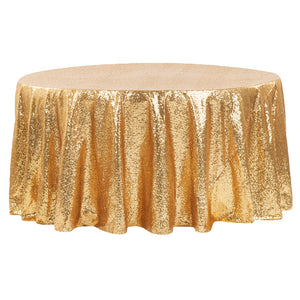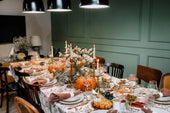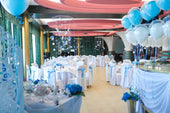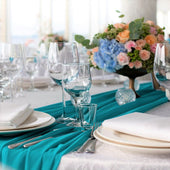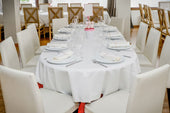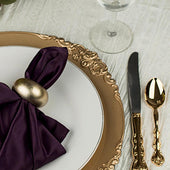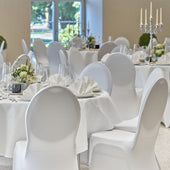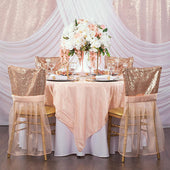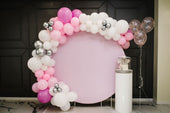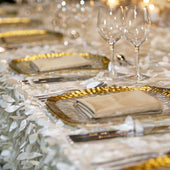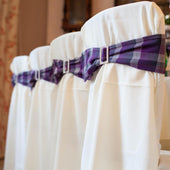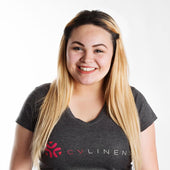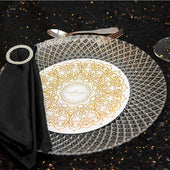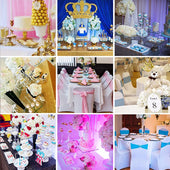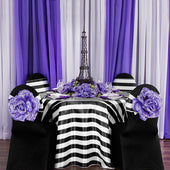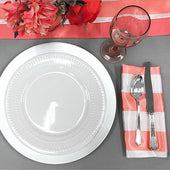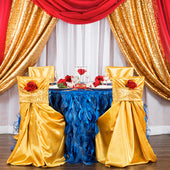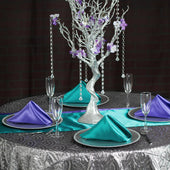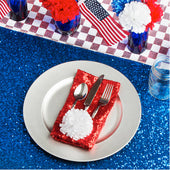Maintaining the beauty and longevity of your tablecloths requires understanding their material. When decorating for an event or keeping your dining area at home looking clean, learning how to wash tablecloths properly with different materials is crucial to maintaining a spot-free tablescape that will be presentable for all.

Washing Tablecloths: A Guide to Different Materials and their Care
For weddings, events, or parties, table linens come in a vibrant design of textures and materials, each adding a unique touch to your table setting. But with this variety comes the challenge of proper care. Neglecting the specific needs of each fabric can lead to shrinkage, fading, or even permanent damage.
Here's a breakdown of the most common tablecloth materials and their specific care needs:
1. Polyester
Polyester tablecloths are durable, wrinkle-resistant, and suitable for any type of event. They come in different sizes and colors that can perfectly match your occasion’s theme. The downside to using them, however, is that they are absorbent, to any stains or blemishes. But washing them should be fairly easy.
When washing polyester linens, you will need to use warm water with regular detergent. Put them in a gentle cycle.
For drying, you can put them in the dryer on low heat to minimize wrinkles.
2. Velvet
Velvet tablecloths are delicate. They have a soft and luxurious texture that is perfect for formal and romantic occasions.
The best way to clean velvet linens is by handwashing them with cold water and mild detergent. Drying them, on the other hand, is simple. Just hang them to air dry to prevent the fibers from crushing.
Avoid ironing since velvet, when heated, can melt and cause it to dry up and ruin the tablecloth.
3. Satin
Satin has a smooth, shiny, and delicate appearance, which produces a great glow. This type of table linen is perfect for formal events like weddings, birthdays, or corporate shows.
Washing them would be just like how you would clean a polyester tablecloth. Add gentle detergent to cold water and spin on a delicate cycle.
There are multiple ways to dry satin. You can either hang and air dry them or put them in a dryer on short tumble dry on low heat.
4. Lace
Lace tablecloth is another delicate material. Usually crafted with a lot of details, its intricate design requires special care and attention.
The best way to clean them is to handwash them with cold water and mild detergent or use a mesh laundry bag on a delicate cycle.
The best way to dry them is to lay them flat to air dry so that the delicate fabric will not fold in ways you don’t want it to go.
5. Plastic
Plastic tablecloths are the easiest to care for when it comes to using them for events. Although they’re commonly used for outdoor dining and are waterproof, they are used for indoor occasions as well.
Cleaning plastic table coverings is as simple as having a damp cloth to wipe clean light messes. However, for tougher stains, you’ll just need to wash them with mild soap and water. Drying them is simple as well. You can wipe them with a dry cloth or leave them to air dry.
6. Burlap
Burlap tablecloths bring a touch of rustic charm to your table. This durable, slightly rough fabric can withstand everyday use. They are perfect for casual gatherings, outdoor dining, picnics, barbecues, or events with a natural theme.
Special care is needed to prevent shrinkage. Wash burlap tablecloths in cold water using a gentle cycle and mild detergent. Air drying is crucial to prevent the fibers from shrinking.
7. Cotton
Cotton remains a classic choice for tablecloths due to its absorbency and breathability. This type of material is perfect for everyday meals, family gatherings, brunches, luncheons, or any casual setting.
Caring for cotton is relatively simple just like how you would on polyester linens. Wash them in warm water using a gentle cycle with regular detergent. You can choose to line-dry your cotton tablecloths or tumble-dry them on low heat to minimize shrinkage.
8. Sequin
The sparkle of sequin tablecloths adds a touch of glamor to your table setting perfect for formal events, weddings, holiday dinners, and special occasions. However, their delicate nature requires extra care.
For washing, it is best to handwash them with cold water and mild detergent. Alternatively, you can use a mesh laundry bag on a delicate cycle. Sequin tablecloths should always be laid flat to air dry.
General Tips
- Always refer to the care label for the most accurate washing instructions.
- Air drying is recommended for delicate materials like lace, velvet, and satin.
- Line drying is a good option for cotton and burlap.
- Tumble drying on low heat can be used for polyester and some cotton tablecloths.
- Store tablecloths in a cool, dry place.
- Fold or roll them neatly to prevent wrinkles.
How to Wash White Tablecloths with Stains
For white tablecloths, pre-treat any stains before washing. Apply a stain remover or a paste of baking soda and water directly to the stain. Let it sit for 15-30 minutes, then follow the washing instructions specific to the material.
As an important note, always test any cleaning solution on an inconspicuous area of the tablecloth first to ensure it doesn't cause discoloration.
Tougher spots like red wine stains require more care. You can use household materials such as bleach or white vinegar. It is also recommended to wash them with hot water to try to remove this tough stain quickly.
By following these guidelines, you can ensure your tablecloths grace your table for countless meals to come. Remember, if you have any doubts, it's always best to consult a professional laundry service for delicate items or heavily stained tablecloths.
Our Products
Sequin Table Linens
Burlap Jute Round Tablecloths
Lamour Satin Tablecloths







